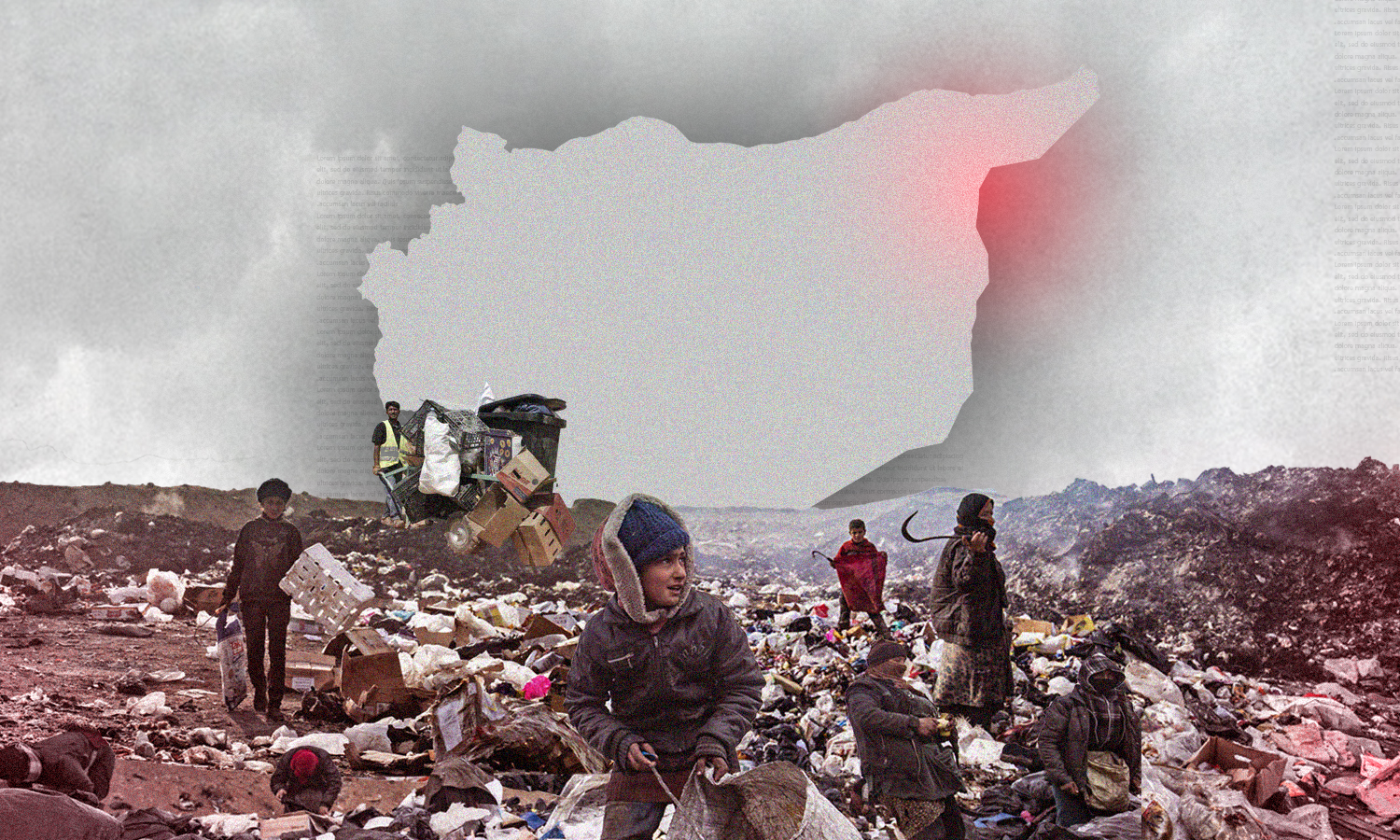



Enab Baladi – Hassan Ibrahim
Mohammad al-Bakour doesn’t fully comprehend the extent of the damage that will affect his 28 olive trees or vegetable crops irrigated with yellow, foul-smelling, polluted water. However, he knows very well that the consequences of continuing to irrigate like this are catastrophic, both on the produce and the plants themselves.
The farmer residing in the village of al-Habat, northern Idlib, noticed the state of the water about eight months ago. He wasn’t surprised as groundwater has become contaminated due to leaks from a six-year-old landfill.
It’s not just al-Bakour and his land and crops. Four villages—Al-Habat, Bahori, al-Saname, and Batinte—have all been affected by the landfill, which now poses a threat to groundwater, crops, and people’s health.
“Our house is ruined,” farmer Khaled Ali al-Jaabi from al-Saname village summarized the extent of the damage caused by the mentioned landfill. He stated that the residents have endured garbage, flies, mosquitoes, and bad odors, but the contamination of water is a disaster.
In 2023, al-Jaabi dug a well over 200 meters deep, costing 5000 USD. However, its water turned yellow with a foul smell three months ago, rendering it useless for irrigation and drinking. He declared, “I will not sell contaminated vegetables to anyone and will not be the cause of others getting sick,” but what is happening is a “disaster for agriculture and health.”
In the village of al-Habat, northern Idlib, under the control of the Syrian Salvation Government (SSG), a quarry has become the main landfill, leading to the contamination of 17 surrounding groundwater wells. Residents continuously demand effective solutions to protect them from skin and internal diseases.
Since 2018, the quarry has stopped extracting stones and building materials, turning into a hotspot for waste and insects. Its 60-meter depth made it hard to approach, turning it into a source of pollution and diseases.
Along with the spread of insects and bad odors, fluid leaks from the garbage reached nearby groundwater wells, turning their water yellow and brown with a foul odor, harming humans and crops.
The problem of waste spread and accumulation isn’t new, but it has worsened with the growing bleak and complex Syrian scene over 13 years. Solid waste management was an acknowledged environmental problem in Syria before 2011, and waste handling was inappropriate, lacking regulatory oversight on emissions. The environmental governance system was weak, according to a report by the Dutch PAX organization.
Across Syrian geography with multiple areas of control, heaps of garbage and waste spread in cities and rural areas, forming breeding grounds for pests, insects, and animals like mosquitoes, flies, rats, cats, and stray dogs. It has become a source of epidemics, diseases, and foul odors, affecting humans and the environment.
The efforts of the Syrian regime government, the Autonomous Administration of North and East Syria (AANES), the Syrian Interim Government (SIG), the Syrian Salvation Government (SSG), and organizations and bodies concerned with protecting the environment are still insufficient to address the waste problem in Syria. No effective solutions have been proposed to stop the detrimental effects of waste on individual health and the environment, with timid attempts not rising to the level of increasing damage.
Before 2011, despite household waste collection, all landfills were open, and waste was often burned in open pits without proper disposal of hazardous waste. Over the years, the escalating violence and conflict exacerbated the situation, according to the PAX report.
Due to the near complete breakdown of waste management services, large quantities of waste remain dumped in streets across the country. Many municipalities have resorted to measures like burning or uncontrolled dumping, increasing the threat of disease and parasite proliferation.
In this lengthy report, Enab Baladi highlights the waste issue in Syria, presenting examples of garbage spread in various cities and rural areas, disposal methods, responsible entities’ management roles, environmental and population impacts, and offers solutions based on studies, experts, and specialists.
Landfills are major contributors to global greenhouse gas emissions since a massive amount of methane and carbon dioxide is generated from the decomposition of waste deposited in these landfills.
Landfills can pollute surface and groundwater through leachate from waste deposits (often if the landfill lacks sufficient lining), emit foul odors, and release bioaerosols (fragmented particles emitted from terrestrial and marine ecosystems into the atmosphere).
Complex chemical and microbiological reactions within landfills often form many gaseous pollutants, persistent organic pollutants (like dioxins and polycyclic aromatic hydrocarbons), heavy metals, and particles.
When acidic gasses reach the atmosphere, they tend to acidify atmospheric moisture, falling as acid rain, harmful to plants. Sulfur dioxide also negatively affects plant growth and productivity.
Waste management collapse or degradation carries several risks. Inappropriate waste collection and disposal can severely pollute air, soil, and water. Uncontrolled waste burning releases smoke and pollutants like dioxins and furans, according to the PAX report.
Air pollution can arise from ash and dust on landfill surfaces and gas emissions from waste decomposition, such as methane and carbon dioxide, as well as smoke from landfill fires.
Leachate formed from waste moisture and raining water infiltration through landfills contaminates groundwater. It can contain heavy metals and high levels of organic and inorganic materials, flowing into sewage systems and open water bodies, negatively affecting water quality.
This process impacts oxygen levels in water, with potentially severe consequences on ecosystems, depending on the organic and inorganic substances present in the landfill, according to the report.
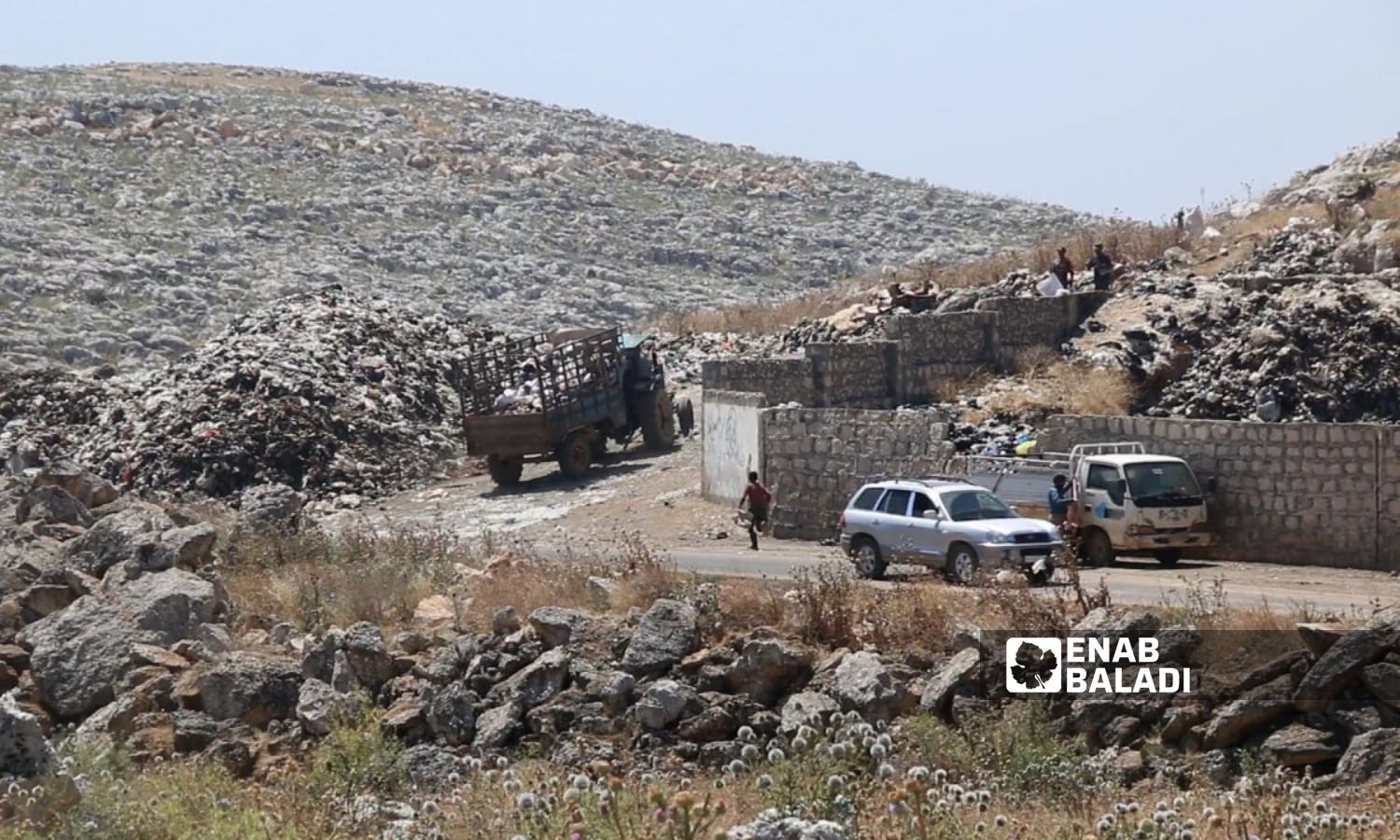
A landfill concerns residents near al-Kuwaiti camp in northern Idlib – June 2024 (Enab Baladi/Iyad Abdul Jawad)
Residents’ anger and denunciation of transforming the quarry in al-Habat village into a garbage dump were insufficient to stop well contamination, threatening lives, including that of Ammar al-Bakour’s cousin, who died from a bloodborne pathogen caused by water pollution from the dump, as reported to Enab Baladi.
Geologist Siraj al-Hariri, responsible for the al-Habat site, told Enab Baladi that several wells in the village were contaminated, mainly due to the dump and other factors such as sewage and medical waste burning.
Al-Hariri reported issuing a report early in 2024, proposing solutions to the problem before the crisis worsens, including stopping the landfill, which has been done, isolating the dump and turning it into a sanitary landfill to collect and treat liquids from solid waste later.
Other suggestions include converting medical incinerators to those with filters and providing proper treatment for incineration outputs. Coordination with many organizations has been initiated, with the UN responding, and an action plan anticipated soon, al-Hariri noted.
As for tangible steps, al-Hariri stated work has begun to open a road to the site’s ground, designate a basin for collecting and drying liquids, and treat the quarry’s ground-standing liquids. The work scope is extensive, involving complexities and requiring time.
In Idlib city and western Aleppo countryside, the E-Clean (Clean Environment) company initiates cleaning some roads and garbage collection per an agreement with the Local Administration Ministry of the Salvation Government, as previously mentioned by the company’s Public Relations Office Manager, Mohammad Salem, to Enab Baladi.
In July 2023, the company started installing eco-friendly underground garbage containers to replace old roadside ones. The plan covers defining 109 points based on technical inspections and consultations with residents and stakeholders to select precise locations.
This approach mitigated waste spread but did not entirely solve the problem, as the area contains over 30 centralized landfills, in addition to subsidiary dumps related to village municipalities and numerous spontaneous dumps near camps.
Although authorities have closed many of these dumps, transferring their waste to neighboring landfills, this isn’t a radical solution despite promises to establish recycling plants.
The Director of the Dumps Department at E-Clean company, Mohammad Korini, told Enab Baladi that the company doesn’t have recycling plants but conducted some experiments yet to be completed.
Korini added that the company selects less annoying and harmful dumps. For instance, they might choose a dump far from residential areas to avoid causing harm, such as odors, smoke, and insects.
He explained that the dump’s damage is mitigated by transforming it into a sanitary landfill, and noted that the company works on burying dumps and planting eucalyptus and oleander trees.
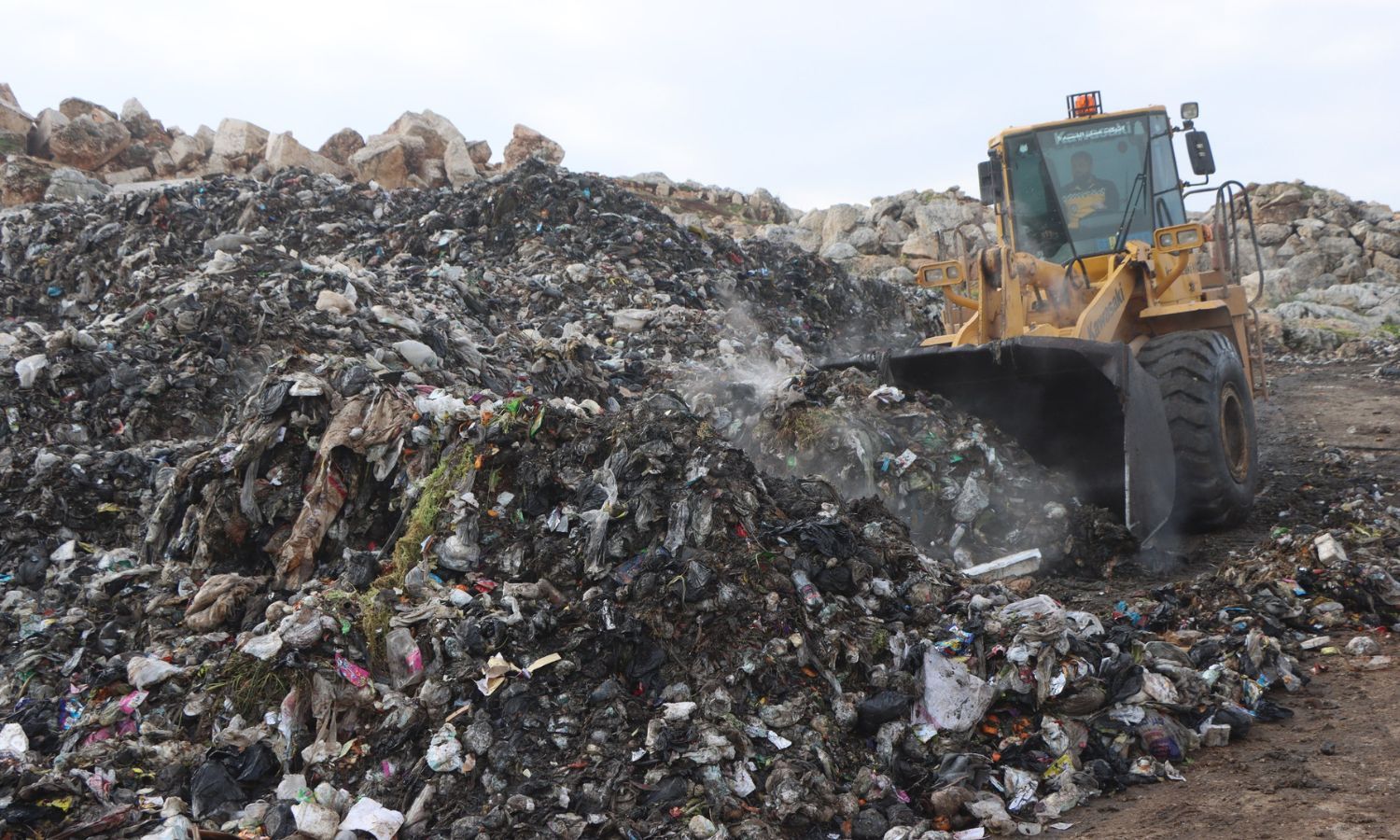
Syria Civil Defence volunteers haul garbage from camps and residential areas in northwestern Syria – May 1, 2024 (Syria Civil Defence)
The waste problem is escalating in northwestern Syria, where 5.1 million people live, 4.2 million of whom need assistance, 3.4 million suffer from food insecurity, 3.4 million are internally displaced, and 2 million reside in camps.
The Syria Civil Defence told Enab Baladi that the spread of landfills poses a health risk, particularly to the respiratory system, which can be gradually and long-term affected by waste burning.
The presence of landfills near camps is considered unhealthy. There’s a similar issue with sewage ponds near camps, villages, and towns. Sometimes waste is burned to dispose of it, releasing harmful smoke, and landfills lead to insect and rodent proliferation, especially in unequipped dumps.
The waste issue in northwestern Syria is one of the disasters set to explode soon. Proper waste management is required to prevent environmental pollution and maintain public health and safety, allowing communities to utilize waste securely.
Syria Civil Defence
The Civil Defence mentioned that its teams worked over the years to remove and bulldoze dumps away from residential areas. However, such activities stopped recently, except for emergencies, due to workload pressure from service projects and local and municipal authority duties.
Besides service projects and activities related to sanitation programs and reducing open sewage and waterborne disease spread, efforts are ongoing to limit their impact on human health and prevent agricultural land pollution.
The Idlib Health Directorate stated that the leakage of liquid waste from the landfill towards groundwater sources has led to their contamination, causing several cases of diarrhea and respiratory infections in the camps and surrounding villages.
Basel Sabbagh, head of the secondary care department in the Idlib Health Directorate, told Enab Baladi that waste has a negative impact on human health. The diseases resulting from it are divided into three types: firstly, respiratory diseases due to foul odors; secondly, digestive system diseases due to the decomposition of waste in the environment and its transmission through water to humans, whether through vegetables, wells, or other means.
The third type of disease is skin diseases, which occur when a person is in direct contact with piles of garbage, according to Sabbagh.
Sabbagh added that it is difficult to determine each illness case and the cause of infection, but in the event of numerous cases from a specific area, the cause is investigated and identified, whether due to waste or other causes. He noted that the failure in waste management impacts dozens of people and entire neighborhoods, and diseases do not occur randomly. Instead, waste piles cause epidemics or pandemics.
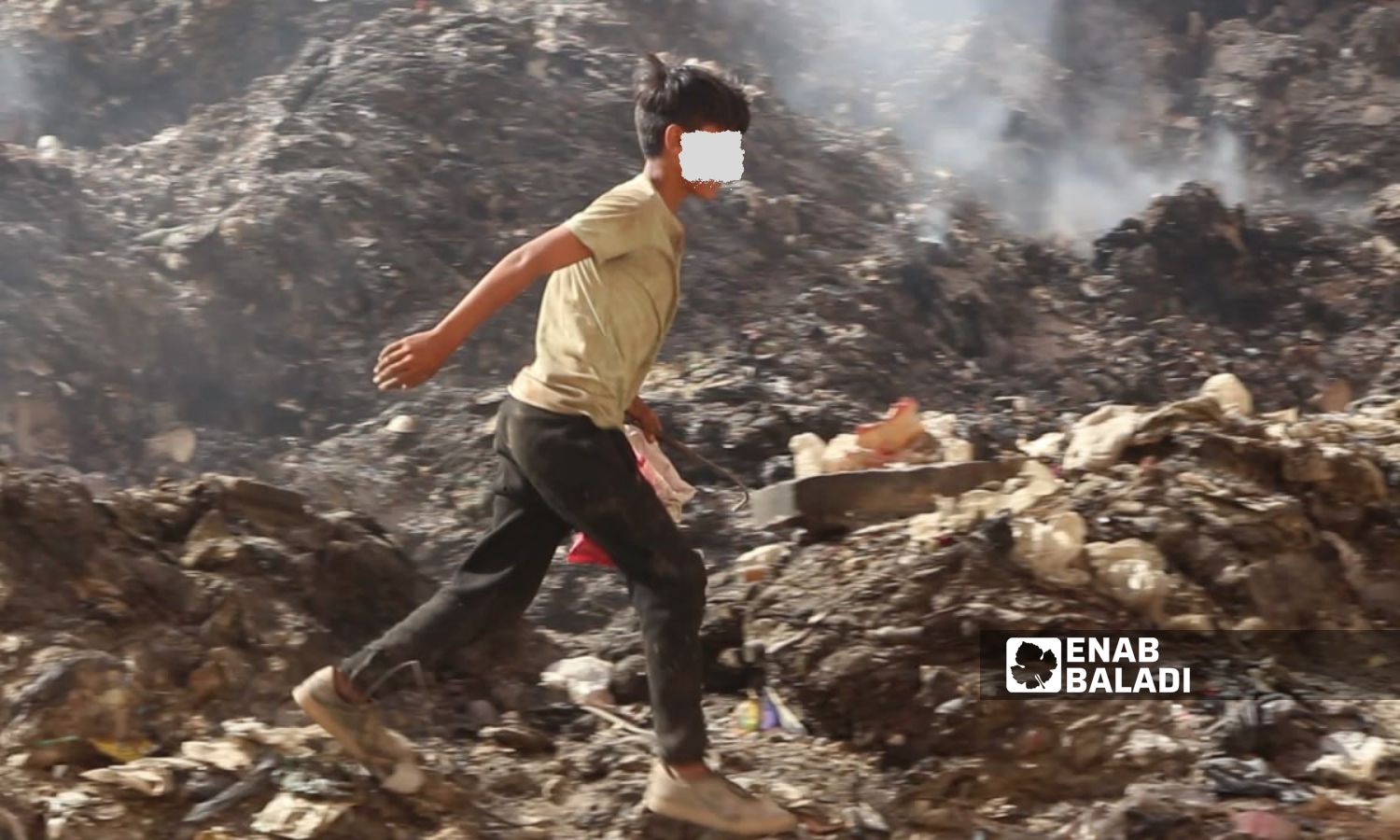
The landfill led to groundwater contamination in the village of al-Habat, north of Idlib – June 12, 2024 (Enab Baladi/Anas al-Khouli)
Prof.Dr. Miassar Alhasan
Sham University Rector in Aleppo Countryside
The phenomenon of environmental pollution continues to worsen globally due to the increasing consumerist lifestyle of the planet’s inhabitants alongside industrial growth.
The United Nations Environment Programme estimates the global production of municipal solid waste to be 2.3 billion tons annually, part of which is treated, while the rest is dumped into the seas or buried in the ground.
Asian countries, especially China, are considered the largest contributors to the planet’s pollution, with their governments facing pressure on their economies and health systems as a result.
The problem of disposing of solid waste in northern Syria has worsened since 2011 due to the absence of a central authority capable of rebuilding the destroyed infrastructure and enforcing laws regulating industrial, agricultural, and municipal activities.
This situation has placed the responsibility of waste transportation on the shoulders of local councils of villages and towns, and sometimes on the residents themselves through volunteer initiatives.
Types of waste:
Waste is classified based on its source (productive, transformational, consumptive), its nature (organic, inorganic), and its treatment method (hazardous, biodegradable, recyclable, solid).
Further classifications include: Industrial Waste (heavy metals, chemical residues), Electrical Waste (broken devices), Commercial Waste (shop and restaurant waste), Agricultural Waste (crop residues, fertilizers, and pesticide containers), Animal Waste (dead animals and manure), Household Waste, Medical Waste (hospital and clinic residues), Organic Waste (food scraps, plants, and wood), and Hazardous Waste (toxic chemicals, radioactive materials, and flammable substances), in addition to Construction Waste (rubble, concrete, wood, and iron).
Syria holds a global rank in construction waste pollution, with the volume of rubble produced from building destruction estimated at 142.5 million tons according to a World Bank report on war damages in Syria.
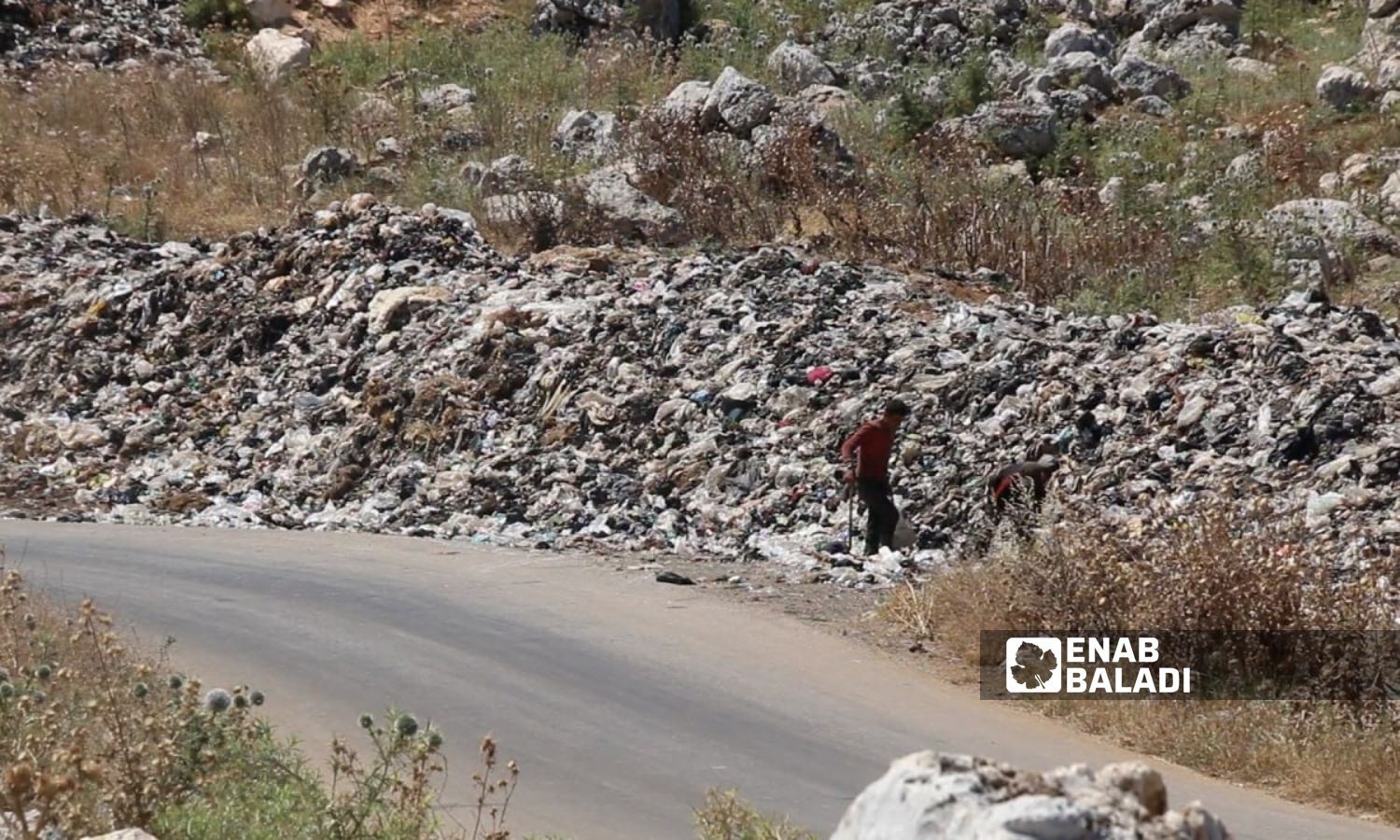
Waste landfill troubles residents near the al-Kuwaiti camp, north of Idlib – June 2024 (Enab Baladi/Iyad Abdul Jawad)
Rainfall causes the breakdown of some components of solid waste, forming a liquid leachate rich in pollutants like heavy metals, organic compounds, and pathogens such as bacteria, viruses, and parasites.
This phenomenon is particularly aggravated in non-equipped landfills lacking suitable liners and filters.
Pollution increases when liquid waste (such as diesel fuels and oils) is disposed of directly without treatment, alongside the surface runoff of industrial and agricultural activity residues.
The danger of solid waste lies in its non-local impact, as leachate carrying toxic substances seeps into the soil, altering its physical structure and chemical composition, thus reducing its quality and its ability to produce human-consumable crops. This harms the food chain and negatively impacts food security.
Leachate also infiltrates groundwater, contaminating it with heavy metals, organic compounds, and pathogens.
This leads to the contamination of well water and the proliferation of insects and rodents, spreading diseases such as intestinal infections, neurological disorders, cholera, and cancers, especially among children and pregnant women.
The impact of waste extends to air pollution resulting from the dumping of solid waste in open landfills, emitting foul odors and toxic gasses that are carried by the wind to other areas, harming the atmosphere and local residents.
Poor waste management in northern Syria continues to have significant environmental impacts. The region lacks regulated landfills, and the existing dumpsites are not equipped with liners to prevent contaminants from seeping into the soil and subsequently into groundwater, affecting both soil productivity and crop quality (UNEP, 2013).
The problem is exacerbated by the dumping of household and industrial waste in water bodies and nearby lands and along roadsides in some areas. Municipalities and residents sometimes resort to open burning to reduce waste accumulation, causing unpleasant odors in areas previously known for their clean air that asthma patients sought out for recovery before 2011.
Wells are the main source of drinking and irrigation water in northern Syria, and their excessive consumption due to drought and the absence of regulatory laws has become a problem in itself. Moreover, pollution has emerged as one of the most pressing environmental issues, especially with the establishment of unregulated landfills that allow solid waste leachate to seep into deep soil.
The altered taste and smell of well water in several Syrian areas indicate the risks of using this water for agricultural irrigation, let alone human consumption.
In regions with limited financial resources, available waste treatment technologies are often not economically viable. Therefore, municipalities resort to the least costly and more dangerous treatment methods, generally moving the waste out of residential areas and storing it in rudimentary dumpsites. However, sustainability requires an integrated treatment approach, including: establishing modern landfills equipped with appropriate liners and leachate collection and treatment systems; sorting and recycling waste to reduce landfill quantities and converting suitable waste into compost; disposing of the rest safely, such as through sanitary landfilling and incineration in designated areas; and enforcing strict measures for the safe disposal of hazardous waste.
Choosing the appropriate method for each type of waste ultimately depends on the available technologies, environmental considerations, and economic factors in each region.
Waiting for a political solution to address environmental challenges in north Syria is no longer realistic.
The solution begins by gathering the necessary information to build a comprehensive view through the meeting of concerned parties and establishing a comprehensive information base. Experts should be attracted to form a team that drafts a strategic plan for sustainable waste management, leveraging past experiences and considering the local context while involving the community in planning and implementation. The plan should also include environmental awareness activities at the popular level. Afterward, substantive changes must be made in waste management policies at the institutional, legal, financial, and social levels, striving for the self-sufficiency of projects, and encouraging investment in facilities for sorting, recycling waste, and water treatment.
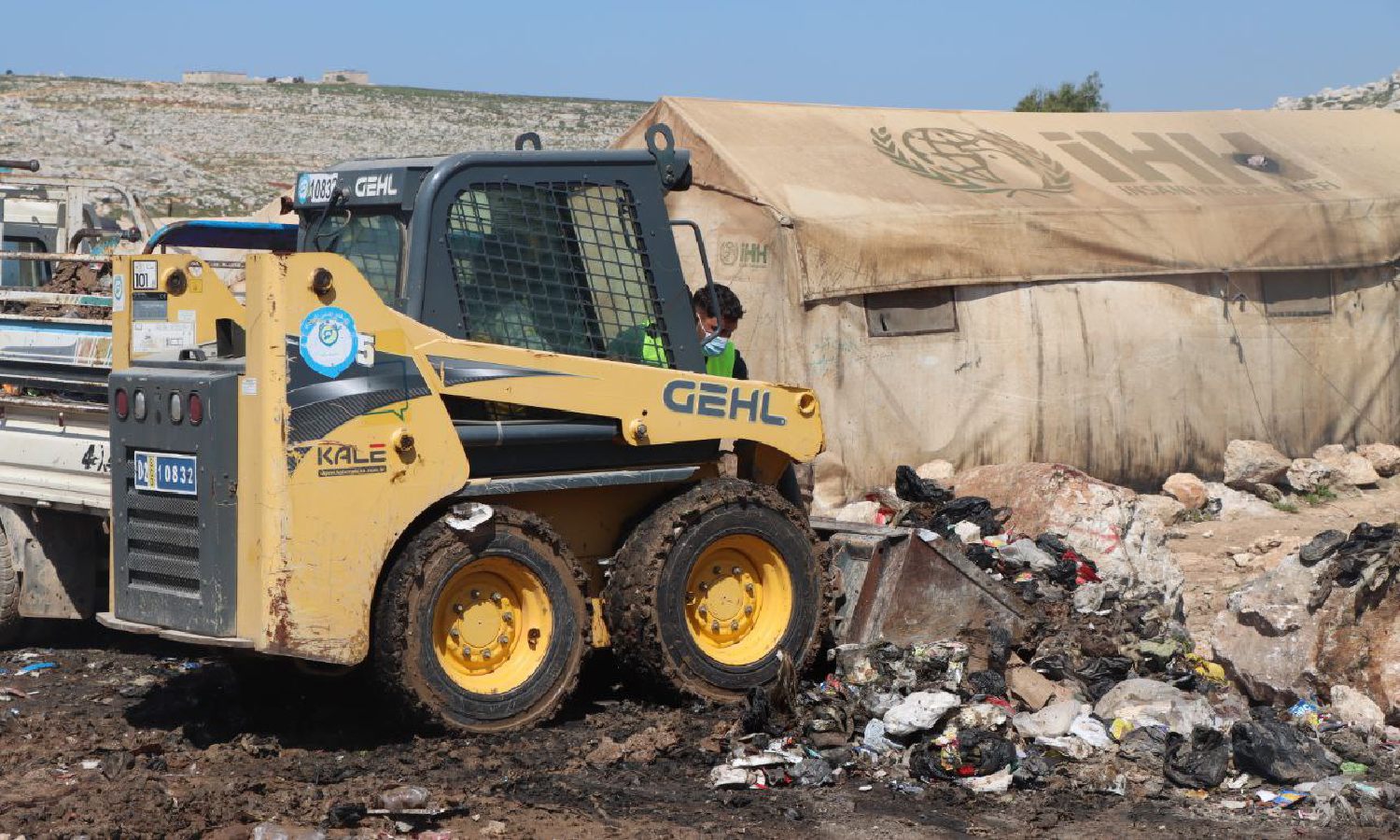
Volunteers from the Syria Civil Defence are relocating garbage from near camps and residential clusters in northwestern Syria – April 15, 2024 (Syria Civil Defence)
In addition to Idlib, Enab Baladi reviews models from four areas under various control in Syria, highlighting the uncontrolled accumulation of solid waste for days and its environmental and health impacts.
To the west of Ras al-Ain, under the control of the Syrian Interim Government, the residents of Tal Arqam village, numbering 1500 people, face diseases and epidemics due to the presence of a landfill near the village on state-owned land.
The landfill is about one kilometer away from the village, and its presence is due to the transfer of waste from Ras al-Ain and surrounding areas to Tal Arqam village. Garbage is collected in specific places within the city center and then transported to the landfill (in Tal Arqam) through municipal tractors.
Mrs. Maram al-Qatifi from Tal Arqam village said that her child suffers from asthma and severe chest allergies, which worsen due to the foul odors emanating from the landfill near her home, in addition to physical problems and skin allergies caused by insects gathered at the dump.
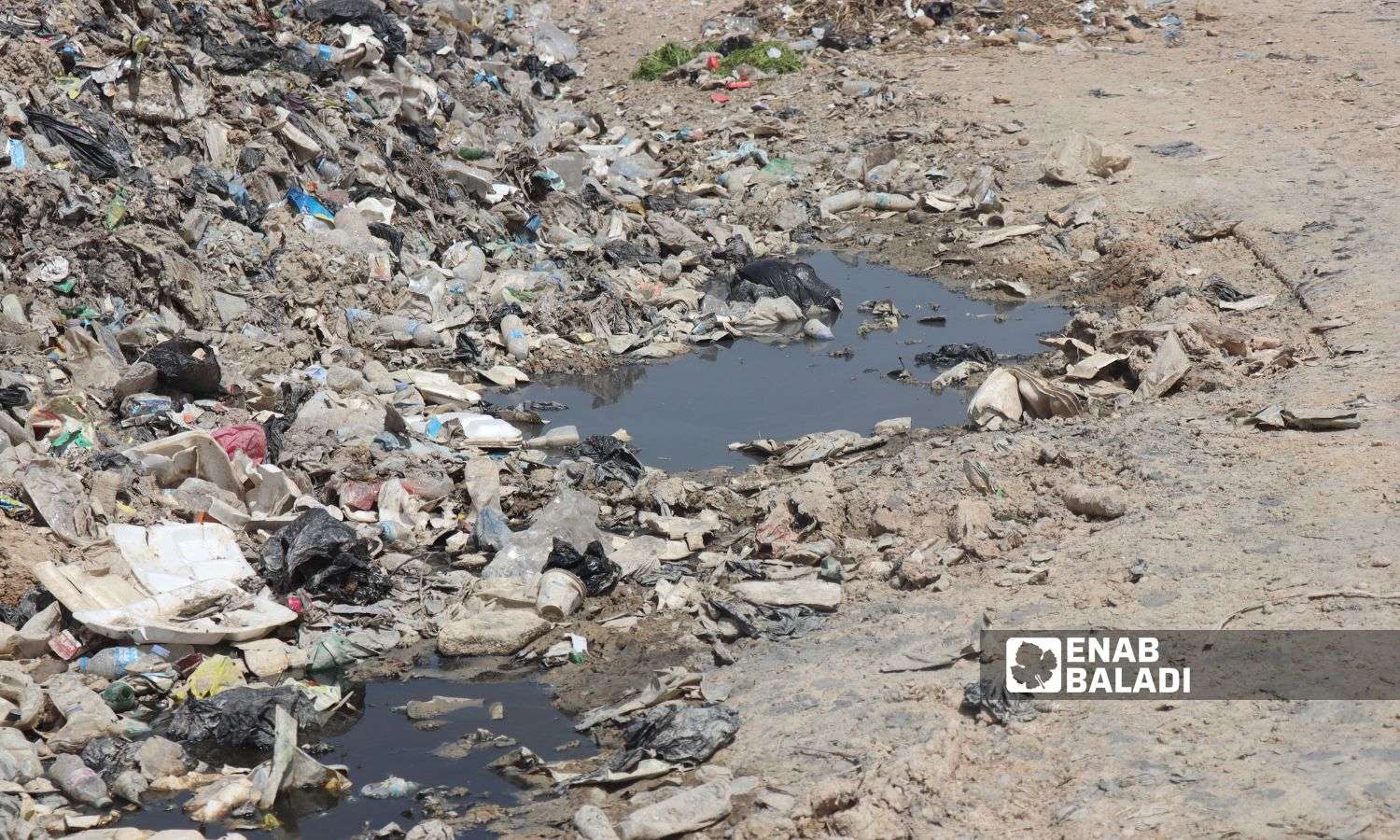
A landfill in Tal Arqam village, west of Ras al-Ain in al-Hasakah, raises concerns for 1500 nearby residents – April 24, 2024 (Enab Baladi)
Mrs. al-Qatifi told Enab Baladi that the village residents had asked the local council to relocate the landfill, and they promised to do so once the new site is ready.
A source in the Ras al-Ain health directorate, requesting anonymity, told Enab Baladi that waste near populated areas causes several diseases, mainly skin and respiratory illnesses.
The source explained that this waste emits methane gas, causing poisoning cases among the residents, especially those with chronic diseases, worsening their health conditions.
The source added that after discussing the issue with the local council and officials, they agreed to move the landfill to a distant area, where the waste would be burned and removed to reduce diseases and epidemics among the residents.
Enab Baladi also interviewed the official spokesperson for the local council, Ziad Maleki, who said that the garbage dump near Tal Arqam is currently used temporarily until the suitable location is prepared. He clarified that the council aims to set up a remote landfill.
He added that the new location would be like a pit in the eastern countryside, where pesticides will be sprayed and the waste burned. He noted that recycling garbage requires significant capabilities the local council currently lacks.
Latakia is one of the most important tourist provinces in Syria, but it’s overflowing with garbage, and containers are bursting with waste on the streets and between houses.
Neighborhoods like al-Ziraa, al-Mashro’ al-Sabe’a (7th Project), and the city’s entrance near the al-Wahda newspaper building and Tishreen University, which were regularly cleaned, are no longer so. Containers overflow because the trash is left for days without removal.
In the summer of 2023, Fadi, 42, suffered a painful bite he thought was from a mosquito, but the injury worsened, and he visited a pharmacy. The pharmacist informed him it was Leishmaniasis and urged him to treat it immediately.
Fadi explained to the doctor that the infection occurred while staying late with acquaintances in a suburb near an overflowing garbage container. The municipality did not regularly remove it, and residents often burned the trash.
Fadi felt a sharp sting but ignored it until the bite site grew after about a week.

Children scavenging in a trash container in al-Mashro’ al-Sabe’a neighborhood in Latakia – February 19, 2024 (Enab Baladi/Linda Ali)
Medical sources at Tishreen University Hospital, who preferred to remain unnamed, told Enab Baladi that many skin diseases spread in summer due to contaminated pool water and germ-ridden insects from garbage.
The most common of these diseases is impetigo, a bacterial infection that enters the skin layers, forming pus-filled blisters and abscesses. The condition can worsen if the patient has diabetes or other immune-impairing diseases, as well as in children suffering from malnutrition or with immature immune systems.
Impetigo is treated based on its severity and spread, either topically or systemically combined with a topical treatment if widespread.
Most hospital patients attribute their infections to non-sterilized pools or insect bites near trash containers. Many of them work in vegetable markets where trash containers are constantly overflowing.
Garbage removal services in Daraa vary by region. The Syrian regime’s institutions mainly focus on the city center of Daraa, while the western and northern countryside face heaps of garbage due to the local councils’ incapacity to remove it. Residents often collect donations to handle trash removal.
Despite the filthy scene and the spread of insects, heaps of garbage are a common sight in the eastern neighborhoods of al-Muzayrib town in western rural Daraa. The local council only cleans the main street, leaving peripheral areas for disorganized removal by residents.
A town notable, who asked not to be named, told Enab Baladi that the municipality often excuses its failure to remove garbage by citing a diesel fuel shortage, and the available allocations are insufficient to clean the entire town.
Residents throw garbage randomly around the town, and some burn it, causing foul odors and posing risks to residents and the environment.
In the city of Tafas, garbage dumps lie less than a kilometer west of inhabited areas. Farmers regularly burn them to prevent the spread that could contaminate surrounding lands.
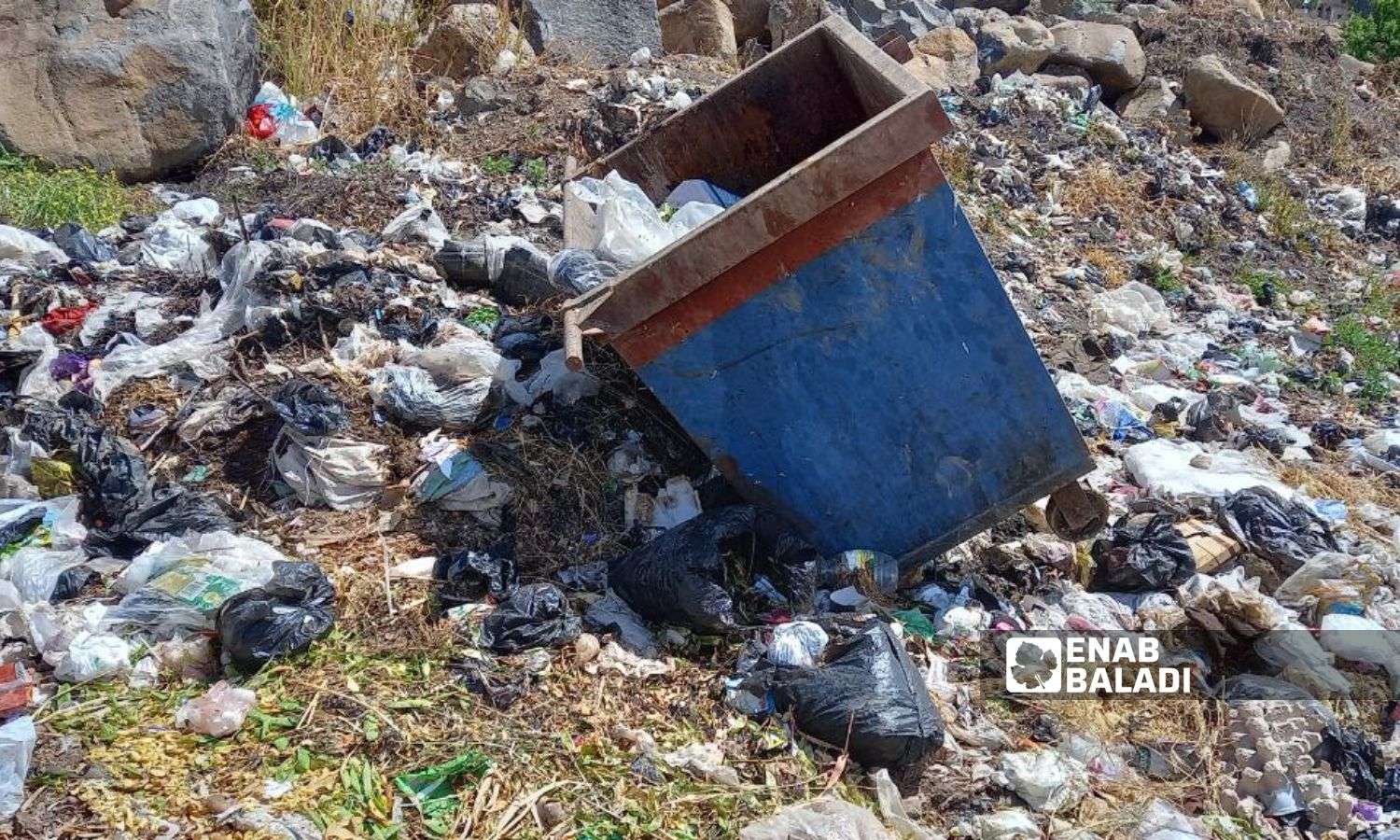
Garbage dumps are frequently found scattered in western rural Daraa – May 6, 2024 (Enab Baladi/Halim Muhammad)
A notable person from Tafas told Enab Baladi that the issue was raised with the public services directorate in Daraa and was approved to move the dump to al-Khader Hill south of the city. However, military forces surrounding the hill prevented tractors from reaching the point.
A new dump was established in al-Zaidi Valley between the towns of al-Yadouda and Tafas, but it is distant, and the fuel allocations are insufficient to reach the new dumps.
In Tal Shihab in western rural Daraa, the local council removes garbage but at a slow pace, taking more than 15 days. Sanitation workers are paid by residents who remove trash from in front of their homes.
The sanitation workers do not cover the entire town, as machinery does not reach the outskirts. This forces residents to throw garbage into the valley west of the town or burn it.
Farmers in the town complained to the technical services directorate because their lands near the Syrian-Jordanian border have turned into garbage dumps, prompting the municipality to change the garbage disposal location.
In Daraa al-Balad, neighboring the city center of Daraa, a member of the local committee told Enab Baladi that the council covers about 75% of sanitation work, and the local committee oversees the council’s work and repairs machinery malfunctions.
When the municipal council falls short, the local committee intervenes, organizing trash removal through community efforts by civilian youths and private machinery.
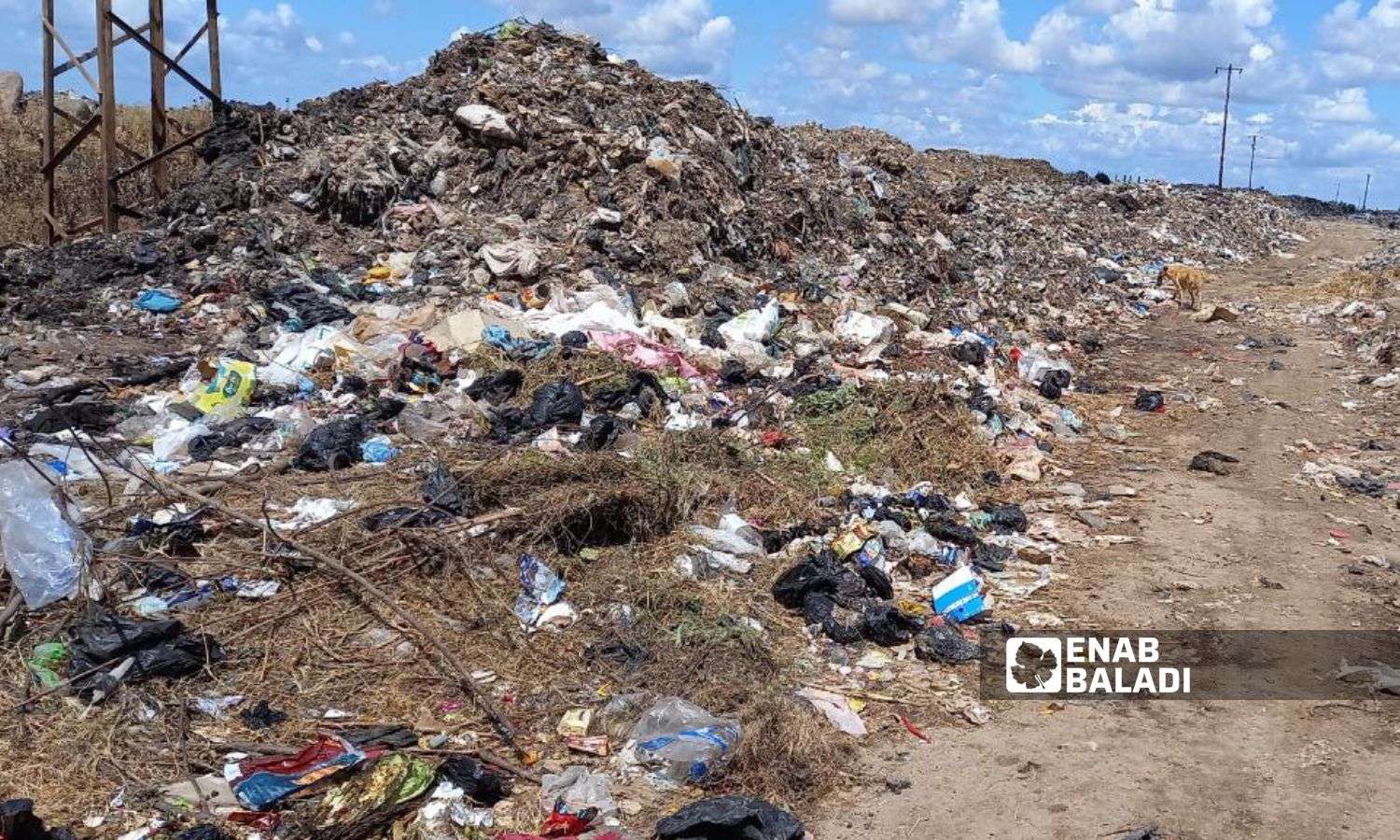
Garbage dumps are frequently found scattered in western rural Daraa – May 6, 2024 (Enab Baladi/Halim Muhammad)
In eastern rural Daraa, local councils handle garbage removal with financial support from residents.
Mohamed al-Mufallani, an activist from the town of Nahta in eastern rural Daraa, told Enab Baladi that the local community covers the repair costs for the council’s machinery, along with providing fuel, avoiding state repair routines that take months.
He added that the town allocates salaries for sanitation workers in addition to their state-provided wages.
Regarding garbage removal, he said it is moved to locations far from residential areas and used as dumping grounds for waste, noting that cleanliness is relatively good in the eastern countryside due to financial funds raised from donations, which support sanitation, electricity, and water networks.

Garbage dumps are frequently found scattered in western rural Daraa – May 6, 2024 (Enab Baladi/Halim Muhammad)
Residents of eastern rural Deir Ezzor villages and towns suffer from accumulated garbage in places like Sabha, Abriha, and al-Basira, leading to foul odors, insect, rodent, and stray dog infestations around waste collection sites.
Where the Autonomous Administration controls, the problem has worsened due to a lack of available machinery for garbage transport and widespread random dumping.
The complaints were not new, as residents interviewed by Enab Baladi stated they had become accustomed to them without any responses.
Mahidi al-Saleh from Sabha expressed his frustration over accumulated waste inside the neighborhoods, forcing residents to often gather trash and burn it randomly or transport it individually outside the town.
Mujahid al-Abdullah from al-Basira city explained that municipal garbage trucks pass through his city’s streets only once every week or ten days, requiring more frequent municipal truck passages. He emphasized the need for a container to collect waste rather than the current unsystematic method described as unorganized.
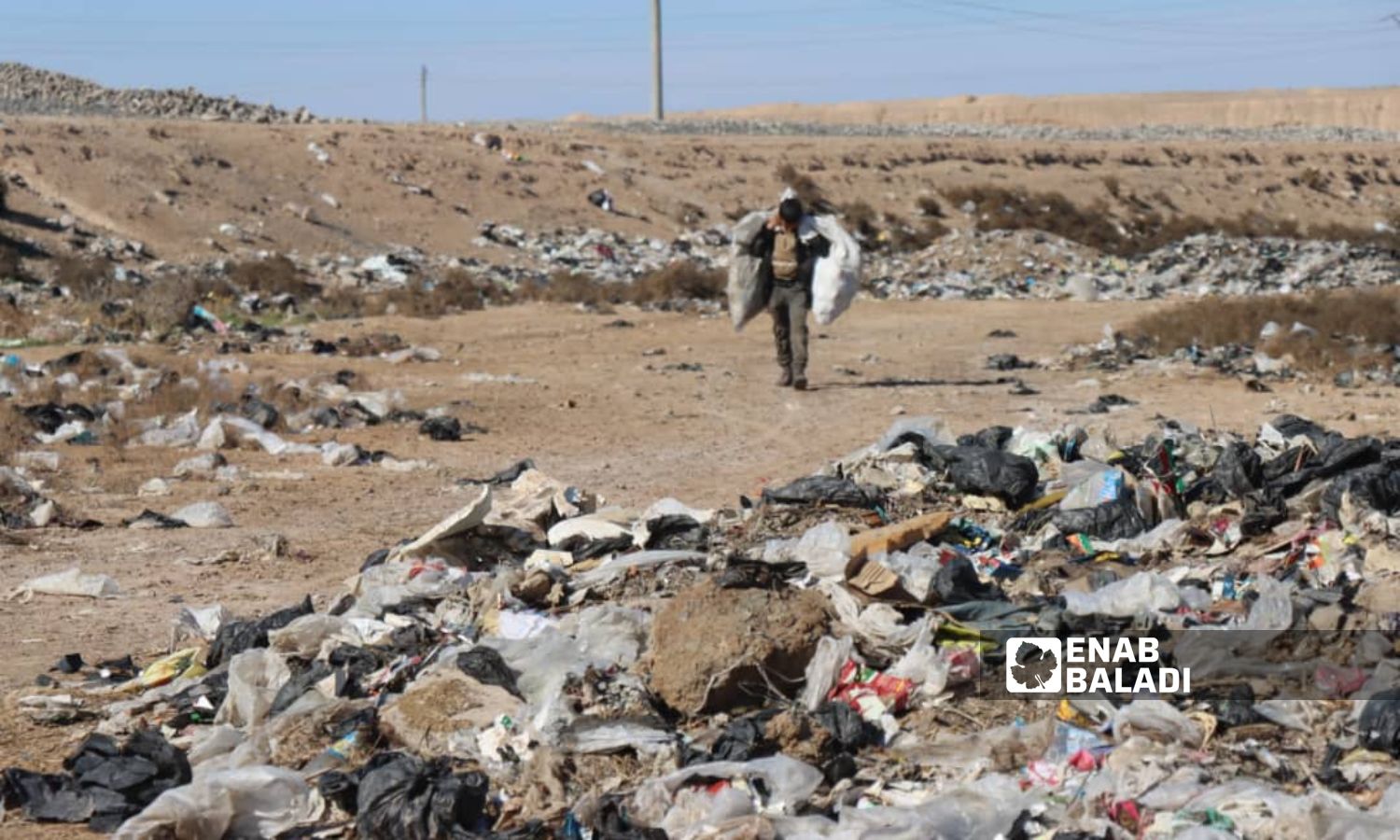
Scrap collection points form at the garbage dumps in Deir Ezzor, affecting environmental and personal health negatively – August 15, 2023 (Enab Baladi/Obadah al-Sheikh)
Due to the local councils and municipal department’s negligence, al-Basira residents and nearby villages now burn heaps of garbage or use private machinery to transport it to the Euphrates riverbed or near the regional railway track.
Nayef al-Takme from Abriha told Enab Baladi that stray dogs and cats have noticeably increased due to the garbage. Residents have made several appeals to officials, but to no avail.
Residents of 20th Street in al-Basira highlighted that rodents have significantly spread in the neighborhood, especially near garbage gathering spots.
An employee of the al-Basira municipality (who requested anonymity because he is not authorized to speak to the media) told Enab Baladi that the municipality has been requesting an increase in machinery and workers for the service committee for years, receiving only promises without actual measures. The area needs more than five vehicles, while currently there are only two.
He mentioned that residents also bear responsibility for maintaining their region’s cleanliness by adhering to designated garbage disposal areas and not throwing it haphazardly in the streets.
Crown Agents provided waste management services in northeastern Syria for three years, employing 405 individuals across 9 villages where waste management operations were conducted. The company’s model showed that for every 1,000 residents in a village, there is a daily waste production of 1.44 cubic meters, but these responses are limited compared to the amount and spread of waste.
The situation in Raqqa is no different from Deir Ezzor. Random dumpsites are widespread in Raqqa’s neighborhoods, within small garden corners or near abandoned and destroyed buildings, causing concern among residents, especially as temperatures rise.

Garbage heaps are scattered randomly in al-Basira’s streets in eastern rural Deir Ezzor – April 23, 2024 (Enab Baladi/Obadh al-Sheikh)
Landfills, the hazardous pollutants they contain, and the gasses and odors they emit affect human health both in the short and long term. The severity of illness and its danger are linked to the emitted gas, as waste produces trace toxic elements including carbon monoxide, hydrogen sulfide, xylene, dioxin, and others, according to a PAX report.
Waste can contain wood, paper, and plastic, and methane gas resulting from decay has high levels of hydrocarbons, phenol, benzene, and heavy metals. These forms of air pollution can create serious health hazards, causing respiratory problems, long-term symptoms of suffocation, chronic diseases, and cancer.
Major health risks of waste
- Loss of concentration, nausea, and vomiting. Continuous inhalation of methane can lead to death.
- Irritation of the nose and throat, bronchoconstriction, shortness of breath, and respiratory infections.
- Reduced lung function, asthma, ataxia, paralysis, and lung cancer due to inhalation of heavy metals.
- High blood pressure and anemia caused by heavy metal pollution. High exposure levels affect the nervous system, causing nerve toxicity, leading to neurological disorders such as memory disturbances, sleep disorders, anger, fatigue, head tremors, blurry vision, and unclear speech.
- Kidney damage, risk of stone formation or kidney calcification, and kidney cancer.
- Dioxin is linked to increased mortality from ischemic heart disease.
- Polycyclic aromatic hydrocarbons are believed to have potential carcinogenic properties upon human contact, possibly leading to lung tumors, skin cancer, and deficiencies in other body parts.
- Human inhalation of fine particles causes inflammation of blood vessel linings, systemic inflammatory changes, and blood clotting, potentially leading to blocked blood vessels, angina, and myocardial infarction.
Source: International Journal of Environmental Research and Public Health.
According to a United Nations Environment Programme (UNEP) report, global solid waste generation is expected to grow from 2.3 billion tons in 2023 to 3.8 billion tons by 2050.
In 2020, the estimated direct global cost of waste management was about 252 billion US dollars. Considering hidden costs of pollution, poor health, and climate change due to poor waste disposal practices, the cost rises to 361 billion US dollars.
Without urgent action on waste management, the annual global cost could nearly double by 2050 to reach 640.3 billion US dollars.
An estimated 11.2 billion tons of solid waste are collected worldwide annually, contributing about 5% of global greenhouse gas emissions (gasses contributing to global warming and climate change) through organic waste decomposition.
Recycling waste preserves resources, as 17 trees and 50% of water can be saved for each ton of recycled paper. Recycling also creates jobs, employing 12 million people in Brazil, China, and the United States alone.
Only 9% of all produced plastic waste has been recycled, about 12% has been incinerated, while the remaining 79% accumulates in landfills, dumps, or the natural environment.
A million plastic bottles are purchased every minute worldwide, while up to 5 trillion single-use plastic bags are used globally every year.
The best sustainable waste management solutions aim not only to reduce the massive volume of waste but also focus on innovative recycling, composting, and waste-to-energy technologies. They contribute to conserving resources and reducing greenhouse gasses, according to a report by Dr. Elizabeth Green, an environment and sustainability expert on the Sigma Earth platform.
The approach of sustainable solutions is based on three main principles: reduce, reuse, and recycle. Sustainable waste management solutions include:
Saudi academic Dr. Mohammed al-Dagheiri proposed four methods for processing solid waste within a cultural geography series at Qassim University. These methods aim to change the properties of hazardous solid waste to make it non-hazardous or less hazardous, allowing safer handling, transfer, collection, storage, or disposal without harming humans and the environment. The methods are:
Landfilling or Sanitary Burial: One of the most common methods for solid waste disposal. Sanitary landfill sites must have special engineering specifications, relying on solid waste packing to accommodate the largest quantity and minimize permeability, covered by an impermeable clay layer.
Careful geological studies of alternative sites must be conducted to ensure no environmental harm from waste decomposition liquids leaking into groundwater.
Incineration: A widely used method globally in recent years, either through high-tech incinerators or open burning in yards for limited available landfill space.
Recycling: Reprocessing waste after collecting and sorting to utilize some components for different purposes.
Organic Decomposition: Converting solid organic waste into organic fertilizers that enhance soil properties through organic fermentation or biodegradation, returning materials to their natural cycle.
Al-Dagheiri, a member of the Organizing Committee of the First International Conference on the Sustainability of Natural Resources 2019, noted that solid waste problems cannot be eliminated entirely. There can be no development and improvement of living standards without increased manufacturing operations, and hence no manufacturing without waste and pollution.
Al-Dagheiri recommends raising awareness among residents through well-studied educational media programs involving all concerned parties to highlight the issue of solid waste. Encouraging solid waste recycling industry projects and providing all necessary information and facilities to motivate investors to focus on recycling industries.
He also recommends deepening environmental awareness principles and concepts among residents through environmental education as part of school curricula, aiming to develop their necessary skills towards the environment and respect the relationship that binds them to their surroundings.
if you think the article contain wrong information or you have additional details Send Correction